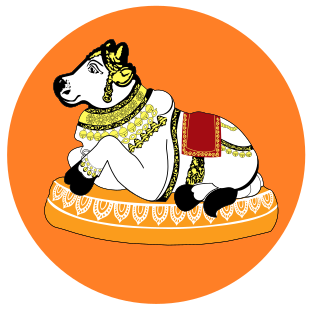
Bhairava, or Kala Bhairava, is a Shaivite and Vajrayāna deity worshipped by Hindus and Buddhists. In Shaivism, he is a powerful manifestation, or avatar, of Shiva. In the tradition of Kashmir Shaivism, Bhairava represents the Supreme Reality, synonymous to Para Brahman. Generally in Hinduism, Bhairava is also called Dandapani, as he holds a rod or danda to punish sinners, and Svaśva, meaning, "he whose vehicle is a dog". In Vajrayana Buddhism, he is considered a fierce emanation of boddhisatva Mañjuśrī, and also called Heruka, Vajrabhairava, and Yamantaka.
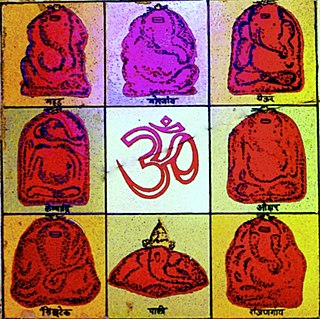
Ashtavinayaka is a Sanskrit term which means "eight Ganeshas". The Ashtavinayaka Yatra refers to a pilgrimage to the eight Hindu temples in the state of Maharashtra, India, centered around the city of Pune. The eight temples house eight distinct idols of Ganesha, the Hindu deity of unity, prosperity, learning, and removing obstacles. Each of these temples has its own individual legend and history, as distinct from each other as the murtis in each temple. The form of each murti of Ganesha and his trunk are distinct from one another. There are other temples of eight Ganesha in various other parts of Maharashtra; however, the ones around Pune are more well known and visited. To complete the Ashtavinayaka Yatra, one must revisit the first temple after visiting all the eight temples.

The Kasba Ganapati refers to both a particular murti of the god Ganapati in Pune, India, as well as to the temple built around the murti. The Kasba Ganapati is the presiding deity (gramadevata) of Pune. Kasba Ganpati is considered the first Manacha Ganpati, or most revered Ganpati, in Pune, Maharashtra. The idol was established in 1893 and is located in the Kasba Peth area of Pune, an ancient part of the city. It is patronized by Ganapati Bapurao Bebhan Durbar and is considered the presiding deity of Pune. The idol is said to be self-made and was originally the size of a grain of rice, but is now larger due to a layer of red sandalwood.
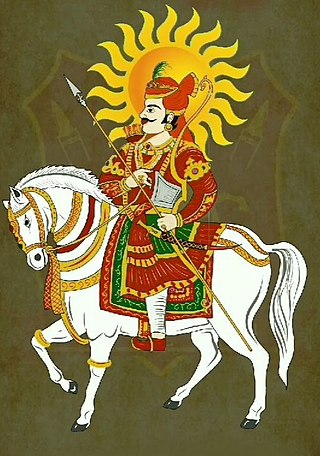
Veer Tejaji also known as Tejaji Maharaj, or simply Tejaji, was a great warrior, social reformer and folk-deity of Rajasthan. In rural parts of northern Rajasthan, he is revered as a deity and is considered to be one of Lord Shiva's eleven primary incarnations. He is mainly worshipped in the states of Rajasthan, Madhya Pradesh, Haryana, Uttar Pradesh, and Gujarat. He is commonly known as the God of Snakes in Rajasthan, because it protect against snake bites or also worshipped as Dhauliya Veer.
Navagraha (Pron: nævəˈgrɑ:ə) pilgrimages are pilgrimages devoted to Navagraha—the nine (nava) major celestial bodies (Grahas) of Hindu astronomy. These temples are made of stone. These celestial bodies are named Surya (Sun), Chandra (Moon), Mangala (Mars), Budha (Mercury), Brihaspati (Jupiter), Shukra (Venus), Shani (Saturn), Rahu and Ketu. Many temples in South India contain a shrine dedicated to the Navagrahas. However, the term Navagraha temples refers to a cluster of nine separate temples, each an abode of one of the Navagrahas.

Gupteswar Cave is a cave shrine dedicated to Shiva. It is a pilgrim site situated about 55 km (34 mi) away Jeypore, Koraput District in the state of Odisha, India. It is a limestone cave, and its main attraction is the gigantic Shiva Linga which is said to be increasing in size. It is believed that the cave was discovered by Rama and re-discovered in the reign of Maharajah Veer Vikram Dev. In the holy month of Shravan, the cave is visited by devotees who walk to the shrine bare-footed with decorated bamboo palanquins called "Kanwadiya" and bathe in the maha kund before worshipping Lord Gupteshwar. There are 200 steps to reach to the Shiva linga temple. Its entrance is about 3 metres (9.8 ft) wide and 2 metres (6.6 ft) high.
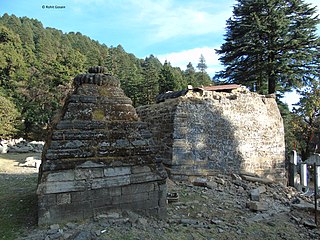
Pauri Garhwal is a district in the Indian state of Uttarakhand. Its headquarters is in the town of Pauri. It is sometimes referred to simply as Garhwal district, though it should not be confused with the larger Garhwal region of which it is only a part of.
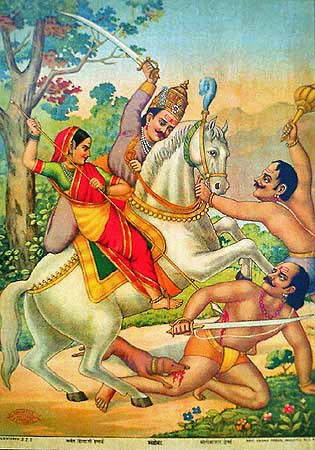
Khandoba, also known as Martanda Bhairava,, Malhari,Mylaralinga,Bandarada Odeya and Malhar, is a Hindu deity worshiped as a manifestation of Shiva mainly in the Deccan plateau of India, especially in the state of Maharashtra and North Karnataka. He is the most popular Kuladevata in Maharashtra. He is also the patron deity of some warrior, farming castes, shepherd community and Brahmin (priestly) castes as well as several of the hunter/gatherer tribes that are native to the hills and forests of this region. The sect of Khandoba has linkages with Hindu and Jain traditions, and also assimilates all communities irrespective of caste, including Muslims. The form of Khandoba developed during the 9th and 10th centuries from a folk deity into a composite god possessing the attributes of Shiva, Bhairava, Surya and Kartikeya (Skanda). He is depicted either in the form of a linga, or as an image of a warrior riding on a bull or a horse. The foremost centre of Khandoba worship is the Khandoba temple of Jejuri in Maharashtra. The legends of Khandoba, found in the text Malhari Mahatmya and also narrated in folk songs, revolve around his victory over demons Mani-malla and his marriages.
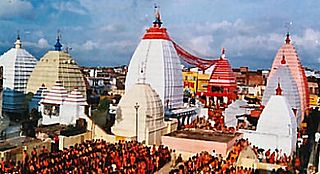
Baidyanath Temple, also known as Baba Baidyanath Dham, is a Hindu temple dedicated to Shiva. It is located in Deoghar, in the Santhal Parganas division of the Indian state of Jharkhand. The temple complex comprises the central shrine of Baba Baidyanath along with 21 additional temples. It is significant to the Hindu sects of Shaivism as this temple is referred to as one of the twelve Jyotirlingas.

Shri Madhavnath Maharaj (1857–1936) was a Hindu saint, of Karvi, Chitrakoot, Madhya Pradesh, who continued the Nath Sampradaya of the famous Navnaths in India.

Ravalnath, also widely known as Roulu, [a] is a popular Hindu deity in Goa and the Sindhudurg district of coastal Maharashtra, in western India. Shrines of Ravalnath are also found in border areas of Belgaum specially in Karle and Uttar Kannada districts as well as coastal areas of Karnataka. He is worshipped as the main deity or an affiliate deity in most temples of Goa. He is associated with the guardian aspect of Shiva.

Changdev Maharaj was a mystical yogi turned saint who is believed to have lived in the village of Vateshwar along the banks of the Tapti River for 1,400 years. Per popular belief, Changdev Maharaj achieved Bhuta Siddhi based on his yogic powers and used these powers to perform various supernatural acts. Even though Changdev Maharaj himself is believed to have had held godly status and followers, his current following is mostly amongst Varkaris due to his association with Dnyaneshwar and Muktabai.

Shri Mayureshwar Mandir or Shri Moreshwar Temple is a Hindu temple (mandir) dedicated to Ganesha, god of wisdom. It is located in Moragaon in Pune District, about 65 km away from Pune city in the Indian state of Maharashtra. The temple is the starting and ending point of a pilgrimage of eight revered Ganesha temples called Ashtavinayaka.

Narayanpur is a small village located in Purandhar valley in Pune district, Maharashtra, India. It is located about 35 km south of Pune city. One can reach Narayanpur from Pune either from Dive ghat and Saswad or from Katraj Ghat and Mumbai-Pune-Satara Road. Narayanpur is situated at the bottom of famous Purandar fort. Lord Indra's second name is Purandar. Indra made austerity on a nearby mountain, hence the name Purandhar valley. This place is also came to be known as Narayanpur by the ancient Narayaneshwar temple. Narayanpur is a paradise for nature lovers.

The Shrinathji Temple is a Hindu temple dedicated to Shrinathji located in Nathdwara. It is considered an important pilgrimage centre by Vaishnavas.

Shri Betal temple (बेताळ) is a Hindu temple in Amona village in the Bicholim taluk of Goa, India. The presiding deity is Betal who is worshiped as a Bhairava form of Shiva in the form of a warrior; normally the idol of Shree Betal is standing in the temple, but during festivals his idol is displayed on a horse back in the village. He is the Gram devata of Amona.
Lingda is a village in Anand district in the Indian state of Gujarat. It is located in Umreth Taluka on the Nadiad-Dakor road. The name was derived from the temple of Lord Shiva, named લીંગડા.
Molthi, a small village of Brahmins in Pauri Garhwal District in the state of Uttarakhand which is fairly illustrious for the holy temple of "Lord Nadbudh Bhairava".

















